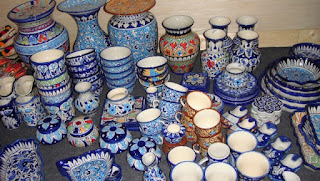Now a languishing craft, this blue pottery is made only by a single family who can trace their lineage back to the Mughals. Blue pottery, characterised by an unusual turquoise aqua blue colour, had very limited centres for production with Delhi as one of the three main centres. The Mughals are said to be the forefathers of this artform after which the craft is supposed to have travelled from Delhi to Jaipur along with the Muslim karigars. They migrated in large numbers, attracted by Raja Man Singh, a great patron of the crafts. Legend has it that blue-pottery items were used by the Mughal kings to test their food as theycould tell by the change in glaze of the pottery that the food had, in all probability, been tampered with or poisoned.

The blue colour is obtained from cobalt oxide and is cast in a mould and glazed. A mixture of quartz, glass, borax, and katira gum sieved through a fine mesh is used to make the body of the object by blending the mixture with water to make a dough which is then cast in moulds. The moulded pieces are then dried and smoothened with sand paper. A thin solution of glass and flintstone mixed with water and wheat is applied on the semi-finished piece and then the desired areas are painted with different pigments. A second coat of glaze, made from a mixture of borax, red lead, and powdered glass is applied, along with wheat flour. The decorated and glazed wares are fired in a kiln at temperatures below 1,000 degrees celsius.

Post a Comment